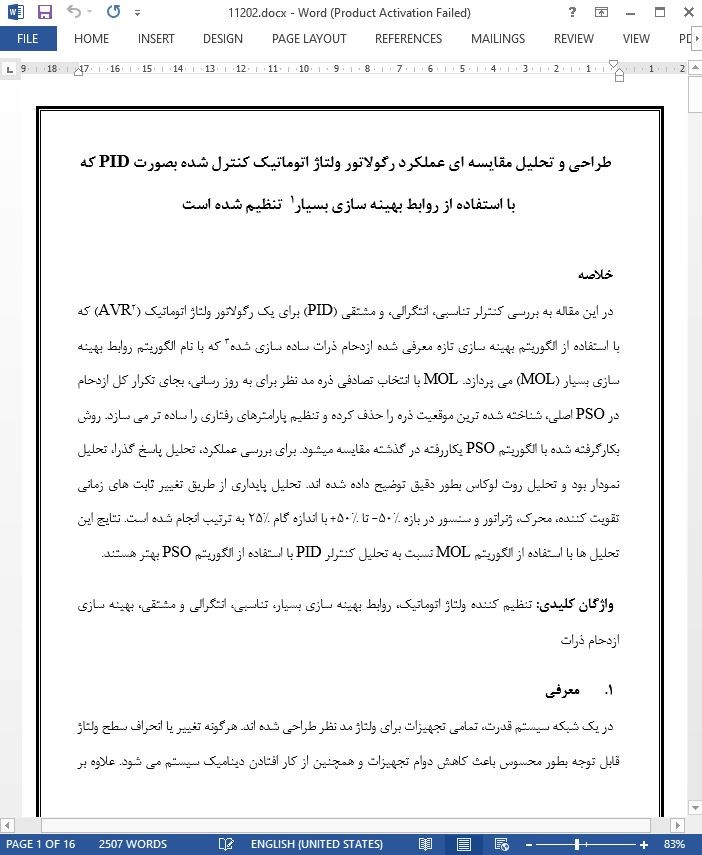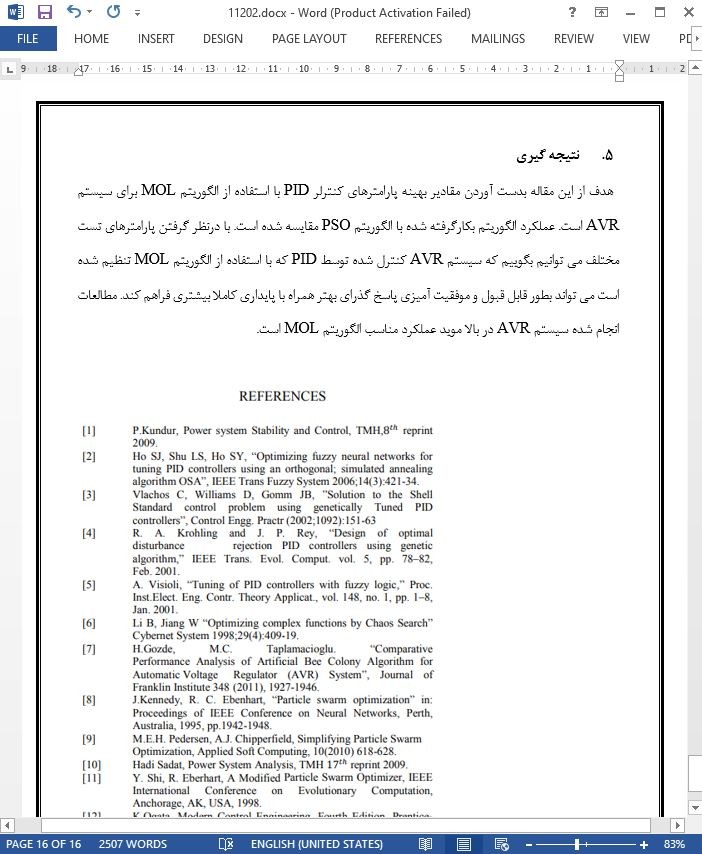
طراحی و تحلیل مقایسه ای عملکرد رگولاتور ولتاژ اتوماتیک کنترل شده بصورت PID
خلاصه
در این مقاله به بررسی کنترلر تناسبی، انتگرالی، و مشتقی (PID) برای یک رگولاتور ولتاژ اتوماتیک (AVR ) که با استفاده از الگوریتم بهینه سازی تازه معرفی شده ازدحام ذرات ساده سازی شده که با نام الگوریتم روابط بهینه سازی بسیار (MOL) می پردازد. MOL با انتخاب تصادفی ذره مد نظر برای به روز رسانی، بجای تکرار کل ازدحام در PSO اصلی، شناخته شده ترین موقعیت ذره را حذف کرده و تنظیم پارامترهای رفتاری را ساده تر می سازد. روش بکارگرفته شده با الگوریتم PSO یکاررفته در گذشته مقایسه میشود. برای بررسی عملکرد، تحلیل پاسخ گذرا، تحلیل نمودار بود و تحلیل روت لوکاس بطور دقیق توضیح داده شده اند. تحلیل پایداری از طریق تغییر ثابت های زمانی تقویت کننده، محرک، ژنراتور و سنسور در بازه 50%- تا 50%+ با اندازه گام 25% به ترتیب انجام شده است. نتایج این تحلیل ها با استفاده از الگوریتم MOL نسبت به تحلیل کنترلر PID با استفاده از الگوریتم PSO بهتر هستند.
1. معرفی
در یک شبکه سیستم قدرت، تمامی تجهیزات برای ولتاژ مد نظر طراحی شده اند. هرگونه تغییر یا انحراف سطح ولتاژ قابل توجه بطور محسوس باعث کاهش دوام تجهیزات و همچنین از کار افتادن دینامیک سیستم می شود. علاوه بر آن، همانطور که می دانیم ولتاژ سیستم تحت تاثیر شار توان راکتیو است، این مورد نیز تحت تاثیر تلفات حقیقی خط است. بنابراین به منظور کاهش تلفات حقیقی توان، سطح ولتاژ سیستم باید بشدت کنترل شود. این مسائل را می توان با استفاده از سیستم رگولاتور ولتاژ اتوماتیک (AVR) که در واحدهای تولید نیرو بکارگرفته شده است برطرف نمود [1]. ولتاژ ترمینال و توان راکتیو نوسانگر توسط AVR کنترل می شود که به نوبه خود منجر به مدیریت مناسب تقسیم توان راکتیو میان تمامی نوسانگرهایی که بصورت موازی به یکدیگر متصل شده اند می شود.
Abstract
This paper deals with the design of Proportional, Integral, and Derivative (PID) controller to an Automatic Voltage Regulator (AVR) tuned by recently developed Simplified Particle Swarm Optimization algorithm so called, Many Optimizing Liaisons (MOL) algorithm. MOL simplifies the original PSO by randomly choosing the particle to update, instead of iterating over the entire swarm thus eliminating the particle's best known position and making it easier to tune the behavioural parameters. The proposed method is compared with the earlier used PSO algorithm. For performance studies; Transient response analysis, Bode plot analysis and Root locus analysis are explained in details. The robustness analysis is done by varying the time constants of amplifier, exciter, generator & sensor in the range of -50% to + 50% with a step size of 25% respectively. The results of these analyses using the MOL algorithm are found to be better with respect to the analysis of the PID controller using PSO algorithm.
I. INTRODUCTION
IN a power system network, all the equipments are designed for rated voltage. Any considerable changes or deviation in the voltage levels considerably reduces the durability of the equipment also hampers the dynamics of the system. Moreover, as known that the system voltage is affected by the reactive power flow this in turn is affected by the real line losses. So, in order to minimize the real power losses, the system voltage level has to be controlled to a great extent. These problems can be solved by using an Automatic Voltage Regulator (AVR) system applied to the power generating units [1]. The terminal voltage and the reactive power of the alternator are controlled by the AVR which in turn, also manages the proper sharing of the reactive power among all the alternators, connected in parallel.
خلاصه
1. معرفی
2. توصیف و مدلسازی یک سیستم AVR
کنترلر تناسبی انتگرالی مشتقی (PID)
3. الگوریتم روابط بهینه سازی بسیار (MOL) استفاده شده در تنظیم پارامتر AVR
4. نتایج شبیه سازی و بررسی
الف. تحلیل پاسخ گذرا
ب. تحلیل بود
پ. تحلیل روت لوکاس
ت. تحلیل پایداری
5. نتیجه گیری
Abstract
I. INTRODUCTION
II. DESCRIPTION AND MODELLING OF AN AVR SYSTEM
III. PROPORTIONAL INTEGRAL DERIVATIVE (PID) CONTROLLER
IV. MANY OPTIMIZING LIAISONS (MOL) ALGORITHM USED FOR AVR PARAMETER TUNING
V. SIMULATION RESULTS AND DISCUSSION
A. Transient Response Analysis
B. Bode Analysis
C. Root Locus Analysis
D. Robustness Analysis
VI. CONCLUSION
- ترجمه فارسی مقاله با فرمت ورد (word) با قابلیت ویرایش، بدون آرم سایت ای ترجمه
- ترجمه فارسی مقاله با فرمت pdf، بدون آرم سایت ای ترجمه



